|
|
|
| A method for fracture density prediction and fluid identification of fractured reservoirs based on azimuthal anisotropic inversion |
WU Yi1( ), ZHOU Chang-Suo1, XU Guo-Xian1, YUAN Jun-Liang1, SONG Xiao-Lin2, ZENG Yong-Jian2( ), ZHOU Chang-Suo1, XU Guo-Xian1, YUAN Jun-Liang1, SONG Xiao-Lin2, ZENG Yong-Jian2( ), WANG Qun-Wu2, ZHANG Kui2 ), WANG Qun-Wu2, ZHANG Kui2 |
1. Research Institute Co.,Ltd.,CNOOC,Beijing 100015,China
2. Beijing Precise Energy Technology Co.,Ltd.,Beijing 100015,China |
|
|
|
|
Abstract The pre-stack anisotropic seismic inversion based on azimuthal seismic data is a key method for fracture detection and fluid identification of fractured reservoirs,which provides effective guidance for exploration and development of fractured reservoirs.However,the anisotropic inversion method under conventional constraints encounters challenges in terms of stability and reliability,with higher requirements being placed for fine characterization of exploration targets.Moreover,there exists a lack of direct inversion methods targeting the fracture density prediction and fluid identification of the fractured reservoirs with high-angle fractures in East China.Therefore,this paper first identified the sensitive factors for fluid identification using multi-well crossplots.Then,based on the poroelasticity theory and the linearized reflection coefficient equation for horizontal transverse isotropy(HTI) media,an azimuthal seismic reflection coefficient equation was deduced,which can reflect the variations of fluid factors and fracture density with the angle of incidence and azimuth angle.Finally,based on the advanced Markov Chain Monte Carlo(MCMC) algorithm,a two-step Bayesian anisotropic seismic inversion method with the L1 norm constraint was proposed,achieving the fluid identification and accurate prediction of fracture density for reservoirs with high-angle fractures.The deduced reflection coefficient equation proved to be feasible through accuracy analysis.In addition,the method proved to be rational and reliable through synthetic seismogram testing and application in actual survey areas,offering a novel solution for the fracture density prediction and fluid identification in such reservoirs.
|
|
Received: 15 April 2025
Published: 23 October 2025
|
|
|
|
|
|

|
Cross plot of isotropic background elastic parameters and longitudinal wave velocity logging curves of actual fractured reservoir working area
|

| Mb/
GPa | μb/
GPa | ρb/
(g·cm-3) | f/GPa | δN | δT | e | | 含气砂岩 | 36.25 | 13.28 | 2.60 | 6.60 | 0.16 | 0.08 | 0.03 | | 泥岩 | 40.75 | 14.22 | 2.70 | 9.00 | 0.05 | 0.03 | 0.01 |
|
Model parameters of double-layer fractured gas-sand and mudstone
|

| Mb/
GPa | μb/
GPa | ρb/
(g·cm-3) | f/GPa | δN | δT | e | | 含水砂岩 | 37.72 | 13.28 | 2.62 | 8.20 | 0.16 | 0.08 | 0.03 | | 泥岩 | 40.75 | 14.22 | 2.70 | 9.00 | 0.05 | 0.03 | 0.01 |
|
Model parameters of double-layer fractured water-sand and mudstone
|

|
Precision comparison and error analysis of reflection coefficient equations based on double-layer fractured gas-bearing sand and mudstone model
|

|
Precision comparison and error analysis of reflection coefficient equations based on double-layer fractured water-bearing sand and mudstone model
|

|
Inversion test of double-layer fractured gas-sand and mudstone models
|
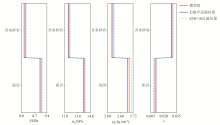
|
Inversion test of double-layer fractured water-sand and mudstone models
|
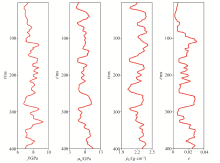
|
Models for synthetic record test
|

|
Synthetic seismogram with noise free
|

|
Synthetic seismogram with signal to noise ratio 10
|
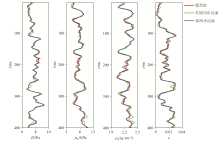
|
Azimuth anisotropy inversion results from synthetic seismic record with noise free
|
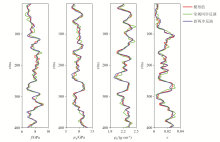
|
Azimuth anisotropy inversion results from synthetic seismic record with signal to noise ratio 10
|
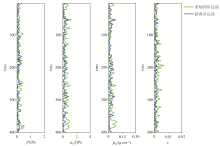
|
Absolute values of error with noise free azimuth anisotropy inversion results and models
|
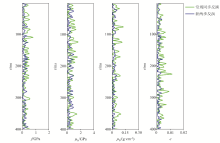
|
Absolute values of error with signal to noise ratio of 10’s azimuth anisotropy inversion results and models
|
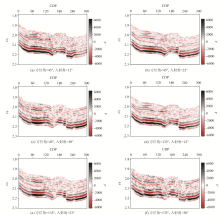
|
Prestack azimuth seismic profiles in an actual fractured working area
|
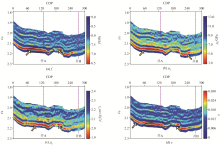
|
Inversion results based on the new Bayesian two step azimuth seismic inversion method
|

|
Inversion results based on the conventional simultaneous azimuth seismic inversion method
|

|
(a) Interlayer slices of fluid factor f (a) and fracture density e (b) inversion results based on the new Bayesian two step azimuth seismic inversion method
|
| [19] |
严彬, 张广智, 李林, 等. 裂缝诱导的TTI介质固液解耦反射系数方程及裂缝和流体参数反演方法[J]. 地球物理学报, 2023, 66(10):4349-4369.
|
| [19] |
Yan B, Zhang G Z, Li L, et al. Fracture-induced fluid-matrix decoupled reflection coefficient equation for TTI media and inversion method for fracture and fluid parameters[J]. Chinese Journal of Geophysics, 2023, 66(10):4349-4369.
|
| [20] |
Schoenberg M, Sayers C M. Seismic anisotropy of fractured rock[J]. Geophysics, 1995, 60(1):204-211.
|
| [21] |
Shaw R K, Sen M K. Born integral,stationary phase and linearized reflection coefficients in weak anisotropic mediaFree[J]. Geophysical Journal International, 2004, 158(1):225-238.
|
| [22] |
Russell B H, Gray D, Hampson D P. Linearized AVO and poroelasticity[J]. Geophysics, 2011, 76(3):C19-C29.
|
| [23] |
Gassmann F. Elastic waves through a packing of spheres[J]. Geophysics, 1951, 16(4):673-685.
|
| [24] |
Bakulin A, Grechka V, Tsvankin I. Estimation of fracture parameters from reflection seismic data:Part I:HTI model due to a single fracture set[J]. Geophysics, 2000, 65(6):1788-1802.
|
| [25] |
彭国民, 刘展. 基于q-高斯分布和零阶最小熵正则化的三维重力聚焦反演[J]. 地球物理学报, 2022, 65(5):1866-1882.
|
| [25] |
Peng G M, Liu Z. 3D focusing inversion of gravity data based on q-Gaussian distribution and zeroth-order minimum entropy regularization[J]. Chinese Journal of Geophysics, 2022, 65(5):1866-1882.
|
| [26] |
Sambridge M, Mosegaard K. Monte Carlo methods in geophysical inverse problems[J]. Reviews of Geophysics, 2002, 40(3):3-1-3-29.
|
| [1] |
裴正林, 董玉珊, 彭苏萍. 裂隙煤层弹性波场方位各向异性特征数值模拟研究[J]. 石油地球物理勘探, 2007, 42(6):665-672,733,606-607.
|
| [1] |
Pei Z L, Dong Y S, Peng S P. Numeric simulation of azimuth anisotropic characters of elastic wavefield in fractural coal seams[J]. Oil Geophysical Prospecting, 2007, 42(6):665-672,733,606-607.
|
| [2] |
Ali A, Jakobsen M. On the accuracy of Rüger's approximation for reflection coefficients in HTI media:Implications for the determination of fracture density and orientation from seismic AVAZ dataFree[J]. Journal of Geophysics and Engineering, 2011, 8(2):372-393.
|
| [3] |
撒利明, 董世泰, 李向阳. 中国石油物探新技术研究及展望[J]. 石油地球物理勘探, 2012, 47(6):1014-1024,844.
|
| [3] |
Sa L M, Dong S T, Li X Y. Research and perspective on new geophysical technologies and methods in China[J]. Oil Geophysical Prospecting, 2012, 47(6):1014-1024,844.
|
| [4] |
薛姣, 顾汉明, 蔡成国. 准静态孔缝介质广义裂隙弱度研究[J]. 石油地球物理勘探, 2015, 50(6):1146-1153,1033-1034.
|
| [4] |
Xue J, Gu H M, Cai C G. General fracture weaknesses for quasi-static porous fractured media[J]. Oil Geophysical Prospecting, 2015, 50(6):1146-1153,1033-1034.
|
| [5] |
印兴耀, 张洪学, 宗兆云. OVT数据域五维地震资料解释技术研究现状与进展[J]. 石油物探, 2018, 57(2):155-178.
|
| [5] |
Yin X Y, Zhang H X, Zong Z Y. Research status and progress of 5D seismic data interpretation in OVT domain[J]. Geophysical Prospecting for Petroleum, 2018, 57(2):155-178.
|
| [6] |
王赟, 文鹏飞, 李宗杰, 等. 多分量油气地震勘探技术急需解决的几个问题[J]. 石油地球物理勘探, 2020, 55(6):13.
|
| [6] |
Wang Y, Wen P F, Li Z J, et al. Several urgent problems in multi-component seismic exploration for oil and gas[J]. Oil Geophysical Prospecting, 2020, 55(6):13.
|
| [7] |
王延光, 尚新民, 芮拥军. 单点高密度地震技术进展、实践与展望[J]. 石油物探, 2022, 61(4):571-590.
|
| [7] |
Wang Y G, Shang X M, Rui Y J. Progress, practice,and prospect of single-sensor high-density seismic technology[J]. Geophysical Prospecting for Petroleum, 2022, 61(4):571-590.
|
| [8] |
Li Y, Guo Z, Liu C. Characterization of fluid-saturated fractures based on seismic azimuthal anisotropy dispersion inversion method[J]. IEEE Transactions on Geoscience and Remote Sensing, 2024,62:5918017.
|
| [9] |
Chen H Z, Ji Y X, Innanen K A. Estimation of modified fluid factor and dry fracture weaknesses using azimuthal elastic impedance[J]. Geophysics, 2018, 83(1):WA73-WA88.
|
| [10] |
Chen H Z, Chen T S, Innanen K A. Estimating tilted fracture weaknesses from azimuthal differences in seismic amplitude data[J]. Geophysics, 2020, 85(3):R135-R146.
|
| [11] |
Ji L X, Zong Z Y, Yang Y M. Azimuthal amplitude difference inversion constrained by azimuth velocity anisotropy[J]. Geophysical Journal International, 2022, 233(1):549-563.
|
| [12] |
Zeng Y J, Zong Z Y, Pan X P. Azimuthal seismic inversion for effective elastic orthorhombic anisotropic media formed by two orthogonal sets of vertical fractures[J]. IEEE Transactions on Geoscience and Remote Sensing, 2023,61:5919813.
|
| [13] |
Liu H, Pan X, Liu Z, et al. Azimuthal prestack seismic inversion for fracture parameters based on L1-2 norm regularization[J]. IEEE Transactions on Geoscience and Remote Sensing, 2024,62:5922410.
|
| [14] |
Zong Z Y, Yin X Y, Wu G C. Elastic impedance parameterization and inversion with Young's modulus and Poisson's ratio[J]. Geophysics, 2013, 78(6):N35-N42.
|
| [15] |
Chen X, Zong Z Y, Qu X Y. P-wave reflectivity parameterization and nonlinear inversion in terms of Young's modulus and Poisson ratio[J]. Interpretation, 2022, 10(3):T415-T428.
|
| [16] |
Pan X P, Zhang G Z. Estimation of fluid indicator and dry fracture compliances using azimuthal seismic reflection data in a gas-saturated fractured reservoir[J]. Journal of Petroleum Science and Engineering, 2018,167:737-751.
|
| [17] |
Feng Y W, Zong Z Y, Zhang G Z, et al. PP-wave reflection coefficient equation for HTI media incorporating squirt flow effect and frequency-dependent azimuthal AVO inversion for anisotropic fluid indicator[J]. IEEE Transactions on Geoscience and Remote Sensing, 2024,62:5906212.
|
| [18] |
Zuo Y H, Zong Z Y, Li K, et al. Bayesian AVOAz inversion of fluid and anisotropy parameters using Gibbs sampling with AISM algorithm[J]. IEEE Transactions on Geoscience and Remote Sensing, 2024,62:4512815.
|
| [27] |
Global optimization methods in geophysical inversion-global optimization methods in geophysical inversion[M]. Cambridge, UK: Cambridge University Press, 2013.
|
| [1] |
CAO Ying-Quan, WANG Lei, LU Fa-Wei, ZHANG Guo-Dong, YU Xi, YANG Yi, YUAN Sheng-Bin, JING She. Identification methods for complex fluids under oil-based drilling fluid conditions: A case study of the Xihu Sag in the East China Sea[J]. Geophysical and Geochemical Exploration, 2025, 49(3): 599-608. |
| [2] |
LIU Wei-Nan, GUAN Yao, LIU Dao-Li, SHI Lei, SONG Wei. Research and application of the log-based comprehensive identification method for low-contrast oil layers:A case study of the Lufeng oilfield in the Pearl River Mouth Basin[J]. Geophysical and Geochemical Exploration, 2024, 48(3): 573-583. |
|
|
|
|

